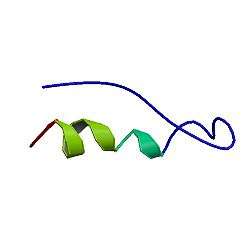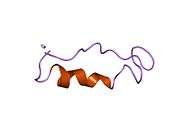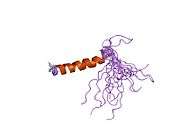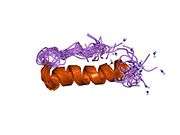Peptide YY
| PYY | |||||||||||||||||
|---|---|---|---|---|---|---|---|---|---|---|---|---|---|---|---|---|---|
 |
|||||||||||||||||
| |||||||||||||||||
| Identifiers | |||||||||||||||||
| Aliases | PYY, PYY-I, PYY1, peptide YY | ||||||||||||||||
| External IDs | OMIM: 600781 MGI: 99924 HomoloGene: 3066 GeneCards: PYY | ||||||||||||||||
| |||||||||||||||||
| Orthologs | |||||||||||||||||
| Species | Human | Mouse | |||||||||||||||
| Entrez | |||||||||||||||||
| Ensembl | |||||||||||||||||
| UniProt | |||||||||||||||||
| RefSeq (mRNA) | |||||||||||||||||
| RefSeq (protein) | |||||||||||||||||
| Location (UCSC) | Chr 17: 43.95 – 44 Mb | Chr 11: 102.11 – 102.11 Mb | |||||||||||||||
| PubMed search | [1] | [2] | |||||||||||||||
| Wikidata | |||||||||||||||||
| View/Edit Human | View/Edit Mouse |
Peptide YY (PYY) also known as peptide tyrosine tyrosine or pancreatic peptide YY3-36 is a peptide that in humans is encoded by the PYY gene.[3] Peptide YY is a short (36-amino acid) peptide released by cells in the ileum and colon in response to feeding. In the blood, gut, and other elements of periphery, PYY acts to reduce appetite; similarly, when injected directly into the central nervous system, PYY is also anorexigenic, i.e., it reduces appetite.[4]
Peptide YY can be produced as the result of enzymatic breakdown of crude fish proteins and ingested as a food product.[5]
Structure
Peptide YY is related to the pancreatic peptide family by having 18 of its 36 amino acids located in the same positions as pancreatic peptide.[6] The two major forms of peptide YY are PYY1-36 and PYY3-36, which have PP fold structural motifs. However, the most common form of circulating PYY immunoreactivity is PYY3-36, which binds to the Y2 receptor (Y2R) of the Y family of receptors.[7] Peptide YY3-36 (PYY) is a linear polypeptide consisting of 36 amino acids with structural homology to NPY and pancreatic polypeptide.
Release
PYY is found in L cells in the mucosa of gastrointestinal tract, especially in ileum and colon. Also, a small amount of PYY, about 1-10%, is found in the esophagus, stomach, duodenum and jejunum.[8] PYY concentration in the circulation increases postprandially (after food ingestion) and decreases by fasting.[7] In addition, PYY is produced by a discrete population of neurons in the brainstem, specifically localized to the gigantocellular reticular nucleus of the medulla oblongata.[9] C. R. Gustavsen et al. had found PYY-producing cells located in the islets of Langerhans in rats. They were observed either alone or co-localized with glucagon or PP.[10]
Function
PYY exerts its action through NPY receptors; it inhibits gastric motility and increases water and electrolyte absorption in the colon.[11] PYY may also suppress pancreatic secretion. It is secreted by the neuroendocrine cells in the ileum and colon in response to a meal, and has been shown to reduce appetite. PYY works by slowing the gastric emptying; hence, it increases efficiency of digestion and nutrient absorption after a meal. Research has also indicated PYY may be useful in removing aluminium accumulated in the brain.
Animal studies
Several studies have shown acute peripheral administration of PYY3-36 inhibits feeding of rodents and primates. Other studies on Y2R-knockout mice have shown no anorectic effect on them. These findings indicate PYY3-36 has an anorectic (losing appetite) effect, which is suggested to be mediated by Y2R. PYY-knockout female mice increase in body weight and fat mass. PYY-knockout mice, on the other hand, are resistant to obesity, but have higher fat mass and lower glucose tolerance when fed a high-fat diet, compared to control mice. Thus, PYY also plays a very important role in energy homeostasis by balancing food intake.[7] PYY oral spray was found to promote fullness.[12] Viral gene therapy of the salivary glands resulted in long-term intake reduction.[13]
Relevance to obesity
Leptin also reduces appetite in response to feeding, but obese people develop a resistance to leptin. Obese people secrete less PYY than non-obese people,[14] and attempts to use PYY directly as a weight-loss drug have met with some success. Researchers noted the caloric intake during a buffet lunch offered two hours after the infusion of PYY was decreased by 30% in obese subjects (P<0.001) and 31% in lean subjects (P<0.001).[15]
While some studies have shown obese persons have lower circulating level of PYY postprandially, other studies have reported they have normal sensitivity to the anorectic effect of PYY3-36. Thus, reduction in PYY sensitivity may not be one of the causes of obesity, in contrast to the reduction of leptin sensitivity. The anorectic effect of PYY could possibly be a future obesity drug.[7]
The consumption of protein boosts PYY levels, so some benefit was observed in experimental subjects in reducing hunger and promoting weight loss.[16] This could partially explain the weight-loss experienced with high-protein diets, but the high thermic effect of protein appears to be the leading cause.
Obese patients undergoing gastric bypass showed marked metabolic adaptations, resulting in frequent diabetes remission 1 year later. When the confounding of calorie restriction is factored out, β-cell function improves rapidly, very possibly under the influence of enhanced GLP-1 responsiveness. Insulin sensitivity improves in proportion to weight loss, with a possible involvement of PYY.[17]
See also
References
- ↑ "Human PubMed Reference:".
- ↑ "Mouse PubMed Reference:".
- ↑ EntrezGene 5697
- ↑ Woods S. C.; D'Alessio D. A. (2008). "Central control of body weight and appetite". J Clin Endocrinol Metab. 93 (11 Suppl 1): S37–50. doi:10.1210/jc.2008-1630.
- ↑ http://www.bio.umass.edu/biology/mccormick/pdf/Murashita%20et%20al%202009.pdf
- ↑ DeGroot, Leslie Jacob (1989). J. E. McGuigan, ed. Endocrinology. Philadelphia: Saunders. p. 2754. ISBN 0-7216-2888-5.
- 1 2 3 4 Murphy KG, Bloom SR (December 2006). "Gut hormones and the regulation of energy homeostasis". Nature. 444 (7121): 854–9. doi:10.1038/nature05484. PMID 17167473.
- ↑ Taylor IL (March 1985). "Distribution and release of peptide YY in dog measured by specific radioimmunoassay". Gastroenterology. 88 (3): 731–7. PMID 3838162.
- ↑ Glavas MM, Grayson BE, Allen SE, Copp DR, Smith MS, Cowley MA, Grove KL (2008). "Characterization of brainstem peptide YY (PYY) neurons". J Comp Neurol. 506 (2): 194–210. doi:10.1002/cne.21543. PMID 18022952.
- ↑ Gustavsen CR, Pillay N, Heller RS (2008). "An immunohistochemical study of the endocrine pancreas of the African ice rat, Otomys sloggetti robertsi". Acta Histochem. 110 (4): 294–301. doi:10.1016/j.acthis.2007.11.003. PMID 18406449.
- ↑ Liu C, Aloia T, Adrian T, Newton T, Bilchik A, Zinner M, Ashley S, McFadden D (1996). "Peptide YY: a potential proabsorptive hormone for the treatment of malabsorptive disorders". Am Surg. 62 (3): 232–6. PMID 8607584.
- ↑ "UF researchers use oral peptide spray to stimulate weight loss in animals". Dec 19, 2013.
- ↑ Acosta A, Hurtado MD, Gorbatyuk O, La Sala M, Duncan D, Aslanidi G, Campbell-Thompson M, Zhang L, Herzog H, Voutetakis A, Baum BJ, Zolotukhin S (2011). "Salivary PYY: a putative bypass to satiety.". PLOS ONE. 6: e26137. doi:10.1371/journal.pone.0026137. PMC 3189958
 . PMID 22028819.
. PMID 22028819. - ↑ Alvarez Bartolomé M, Borque M, Martinez-Sarmiento J, Aparicio E, Hernández C, Cabrerizo L, Fernández-Represa JA (June 2002). "Peptide YY secretion in morbidly obese patients before and after vertical banded gastroplasty". Obes Surg. 12 (3): 324–7. doi:10.1381/096089202321088084. PMID 12082881.
- ↑ Batterham RL, Cohen MA, Ellis SM, Le Roux CW, Withers DJ, Frost GS, Ghatei MA, Bloom SR (September 2003). "Inhibition of food intake in obese subjects by peptide YY3-36". The New England Journal of Medicine. 349 (10): 941–8. doi:10.1056/NEJMoa030204. PMID 12954742.
- ↑ Batterham RL, Heffron H, Kapoor S, Chivers J, Chandarana K, Herzog H, Le Roux CW, Thomas EL, Bell JD, Withers DJ (2006). "Critical role for peptide YY in protein-mediated satiation and body-weight regulation". Cell Metabolism. 4 (3): 223–233. doi:10.1016/j.cmet.2006.08.001. PMID 16950139.
- ↑ Nannipieri M, Baldi S, Mari A, Colligiani D, Guarino D, Camastra S, Barsotti E, Berta R, Moriconi D, Bellini R, Anselmino M, Ferrannini E (November 2013). "Roux-en-Y Gastric Bypass and Sleeve Gastrectomy: Mechanisms of Diabetes Remission and Role of Gut Hormones". J. Clin. Endocrinol. Metab. 98 (11): 4391–9. doi:10.1210/jc.2013-2538. PMID 24057293.
Further reading
- Ekblad E, Sundler F (2002). "Distribution of pancreatic polypeptide and peptide YY". Peptides. 23 (2): 251–61. doi:10.1016/S0196-9781(01)00601-5. PMID 11825640.
- Sandström O, El-Salhy M (2002). "Ontogeny and the effect of aging on pancreatic polypeptide and peptide YY". Peptides. 23 (2): 263–7. doi:10.1016/S0196-9781(01)00603-9. PMID 11825641.
- Yang H (2002). "Central and peripheral regulation of gastric acid secretion by peptide YY". Peptides. 23 (2): 349–58. doi:10.1016/S0196-9781(01)00611-8. PMID 11825649.
- Naruse S, Kitagawa M, Ishiguro H, Hayakawa T (2002). "Feedback regulation of pancreatic secretion by peptide YY". Peptides. 23 (2): 359–65. doi:10.1016/S0196-9781(01)00612-X. PMID 11825650.
- Aponte GW (2002). "PYY-mediated fatty acid induced intestinal differentiation". Peptides. 23 (2): 367–76. doi:10.1016/S0196-9781(01)00613-1. PMID 11825651.
- Hagan MM (2002). "Peptide YY: a key mediator of orexigenic behavior". Peptides. 23 (2): 377–82. doi:10.1016/S0196-9781(01)00614-3. PMID 11825652.
- Mannon PJ (2002). "Peptide YY as a growth factor for intestinal epithelium". Peptides. 23 (2): 383–8. doi:10.1016/S0196-9781(01)00615-5. PMID 11825653.
- Tseng WW, Liu CD (2002). "Peptide YY and cancer: current findings and potential clinical applications". Peptides. 23 (2): 389–95. doi:10.1016/S0196-9781(01)00616-7. PMID 11825654.
- El-Salhy M, Suhr O, Danielsson A (2002). "Peptide YY in gastrointestinal disorders". Peptides. 23 (2): 397–402. doi:10.1016/S0196-9781(01)00617-9. PMID 11825655.
- Imamura M (2002). "Effects of surgical manipulation of the intestine on peptide YY and its physiology". Peptides. 23 (2): 403–7. doi:10.1016/S0196-9781(01)00618-0. PMID 11825656.
- Beglinger C, Degen L (2007). "Gastrointestinal satiety signals in humans--physiologic roles for GLP-1 and PYY?". Physiol. Behav. 89 (4): 460–4. doi:10.1016/j.physbeh.2006.05.048. PMID 16828127.
- Eberlein GA, Eysselein VE, Schaeffer M, Layer P, Grandt D, Goebell H, Niebel W, Davis M, Lee TD, Shively JE, et al. (1989). "A new molecular form of PYY: structural characterization of human PYY(3-36) and PYY(1-36)". Peptides. 10 (4): 797–803. doi:10.1016/0196-9781(89)90116-2. PMID 2587421.
- Facer P, Bishop AE, Cole GA, Aitchison M, Kendall CH, van Aswegen G, Penketh RJ, Rodek CH, McKeever P, Polak JM (1989). "Developmental profile of chromogranin, hormonal peptides, and 5-hydroxytryptamine in gastrointestinal endocrine cells". Gastroenterology. 97 (1): 48–57. PMID 2721879.
- Tatemoto K, Nakano I, Makk G, Angwin P, Mann M, Schilling J, Go VL (1989). "Isolation and primary structure of human peptide YY". Biochem. Biophys. Res. Commun. 157 (2): 713–7. doi:10.1016/S0006-291X(88)80308-5. PMID 3202875.
- Lukinius AI, Ericsson JL, Lundqvist MK, Wilander EM (1986). "Ultrastructural localization of serotonin and polypeptide YY (PYY) in endocrine cells of the human rectum". J. Histochem. Cytochem. 34 (6): 719–26. doi:10.1177/34.6.3517149. PMID 3517149.
- Adrian TE, Ferri GL, Bacarese-Hamilton AJ, Fuessl HS, Polak JM, Bloom SR (1985). "Human distribution and release of a putative new gut hormone, peptide YY". Gastroenterology. 89 (5): 1070–7. PMID 3840109.
- Lundell I, Blomqvist AG, Berglund MM, Schober DA, Johnson D, Statnick MA, Gadski RA, Gehlert DR, Larhammar D (1996). "Cloning of a human receptor of the NPY receptor family with high affinity for pancreatic polypeptide and peptide YY". J. Biol. Chem. 270 (49): 29123–8. doi:10.1074/jbc.270.49.29123. PMID 7493937.
- Bard JA, Walker MW, Branchek TA, Weinshank RL (1995). "Cloning and functional expression of a human Y4 subtype receptor for pancreatic polypeptide, neuropeptide Y, and peptide YY". J. Biol. Chem. 270 (45): 26762–5. doi:10.1074/jbc.270.45.26762. PMID 7592911.
- Hort Y, Baker E, Sutherland GR, Shine J, Herzog H (1995). "Gene duplication of the human peptide YY gene (PYY) generated the pancreatic polypeptide gene (PPY) on chromosome 17q21.1". Genomics. 26 (1): 77–83. doi:10.1016/0888-7543(95)80085-Z. PMID 7782089.
- Kohri K, Nata K, Yonekura H, Nagai A, Konno K, Okamoto H (1993). "Cloning and structural determination of human peptide YY cDNA and gene". Biochim. Biophys. Acta. 1173 (3): 345–9. doi:10.1016/0167-4781(93)90136-2. PMID 8318545.
External links
- Peptide YY at the US National Library of Medicine Medical Subject Headings (MeSH)




